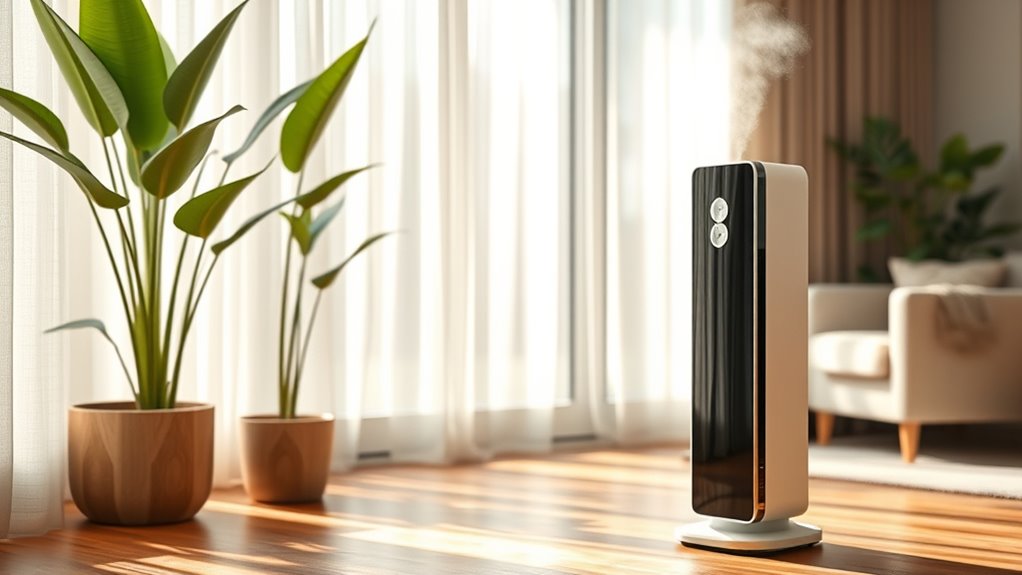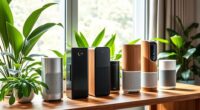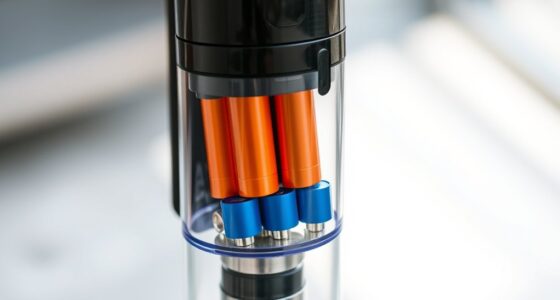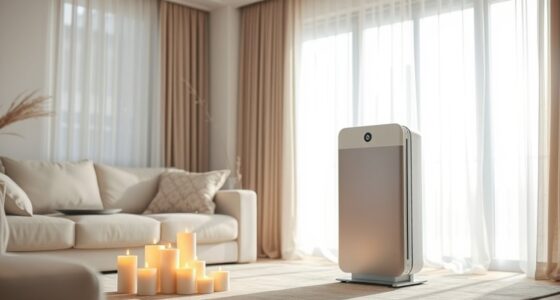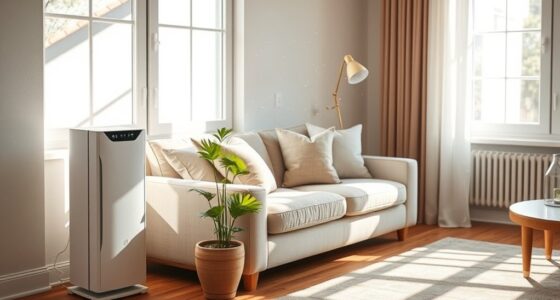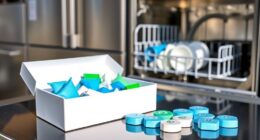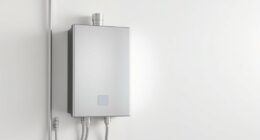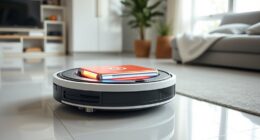Air purifiers are essential for boosting indoor air quality by removing allergens and pollutants like dust, pet dander, and pollen. They use HEPA filters to capture up to 99.97% of harmful particles, making them ideal for asthma and allergy sufferers. However, be cautious with ozone generators, which can harm your health. To maximize benefits, maintain your purifier regularly. You’ll find that there’s even more to learn about choosing the right air purifier and maintaining a healthy home environment.
Key Takeaways
- Air purifiers improve indoor air quality by filtering allergens and pollutants, benefiting respiratory health, especially for those with asthma and allergies.
- HEPA filters capture 99.97% of particles, while activated carbon filters address odors and gases for a comprehensive purification process.
- Regular maintenance, including timely filter replacements, is crucial for optimal air purifier performance and effectiveness in improving air quality.
- Avoid ozone generators, as they can worsen respiratory issues and are not effective in removing particulate matter, according to EPA guidelines.
- Combining air purifiers with good ventilation practices, like regular vacuuming and using exhaust fans, enhances overall indoor air quality.
Understanding Air Purifiers: Purpose and Need
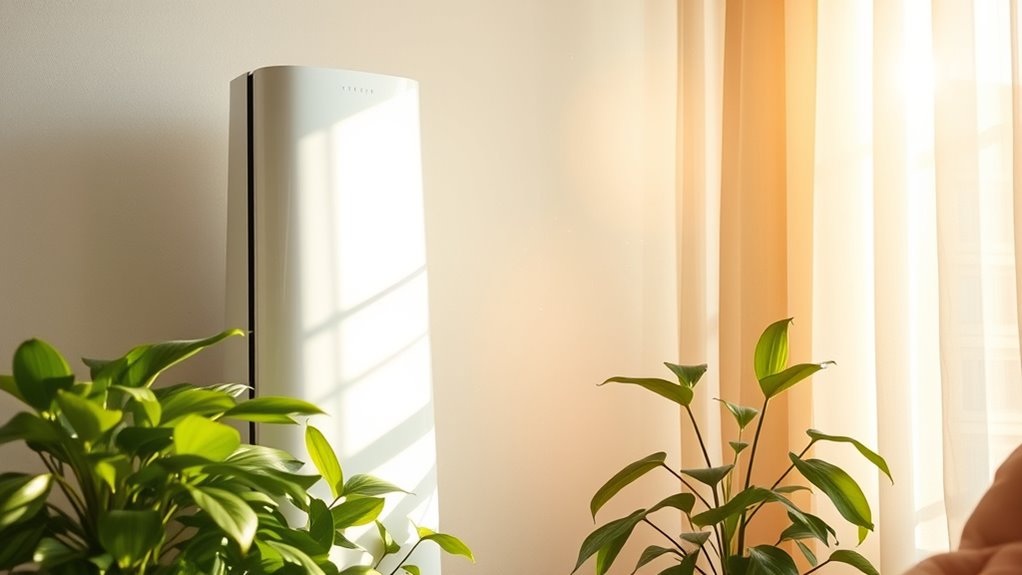
When it comes to maintaining a healthy living environment, understanding air purifiers can make a notable difference.
These portable devices filter air in a single room, effectively reducing airborne allergens and pollutants like dust, mold, and pet dander. Equipped with HEPA filters, air purifiers capture 99.97% of particles sized 0.3 micrometers, targeting common irritants such as viral droplets and pollen. Regular use of air purifiers can lead to improved respiratory health, providing relief to those with asthma and allergies. Additionally, many air purifiers utilize UV light technology to help eliminate germs and bacteria, further enhancing air quality. Proper filter maintenance ensures that the air purifier operates at peak efficiency, maximizing its effectiveness in improving indoor air quality. Furthermore, air purifiers featuring smart capabilities allow users to monitor air quality and control settings conveniently from their devices.
Air purifiers effectively reduce indoor allergens and pollutants, capturing 99.97% of harmful particles for cleaner air.
If you suffer from allergies or asthma, air purifiers can notably lower indoor allergen levels and enhance your respiratory health.
The Clean Air Delivery Rate (CADR) measures their efficiency, showing how much clean air they deliver per minute—higher ratings mean better performance. Additionally, many models come with smart features that allow for convenient control and monitoring of air quality.
How Air Purifiers Work
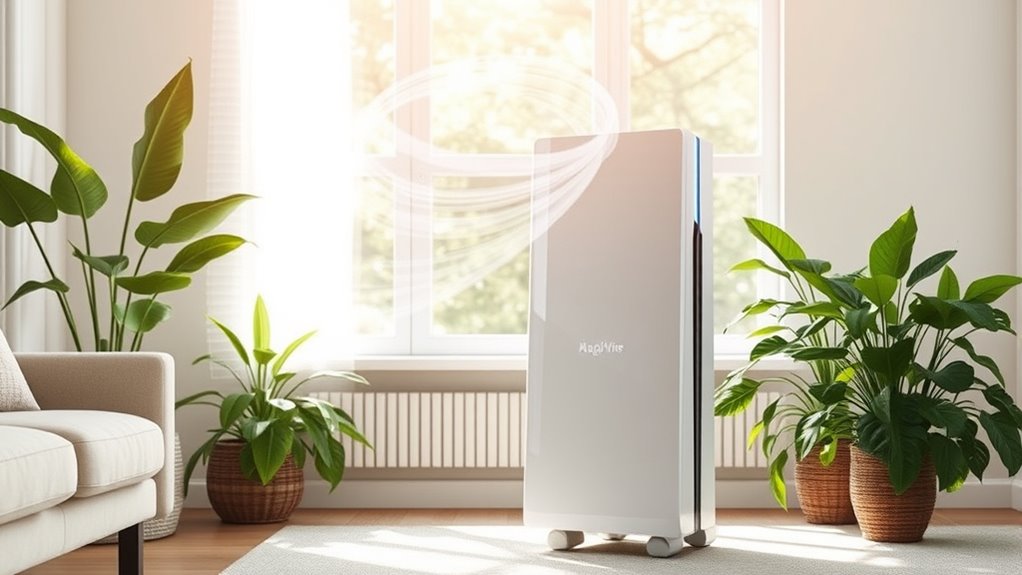
Air purifiers work by efficiently drawing in indoor air, filtering it through specialized systems, and releasing cleaner air back into your living space.
They greatly improve indoor air quality by capturing airborne particles, including allergens like dust and pet dander, thanks to HEPA filters that trap at least 99.97% of particles as small as 0.3 micrometers. Additionally, many models utilize UV-C light technology to further enhance germ and odor elimination. Some advanced models, such as the IQAir HealthPro Series, offer high-end purification technology designed for serious air quality concerns. The cost of home security systems can vary, making it essential to consider your budget when investing in any home improvement, including air purifiers. Regular filter replacement guidelines are also necessary to ensure optimal performance and efficiency. The air delivery rate (CADR) indicates how effectively your air purifier clears specific pollutants; higher CADR values mean quicker filtration.
Some models also include activated carbon filters, which tackle gases and odors.
To maintain their effectiveness, it’s essential to regularly replace filters every 6 to 12 months, ensuring your air purifier continues to combat indoor pollutants effectively. Additionally, regular maintenance is crucial to optimize air purifier efficiency, so make sure to clean and check filters as recommended.
Different Types of Air Purifiers
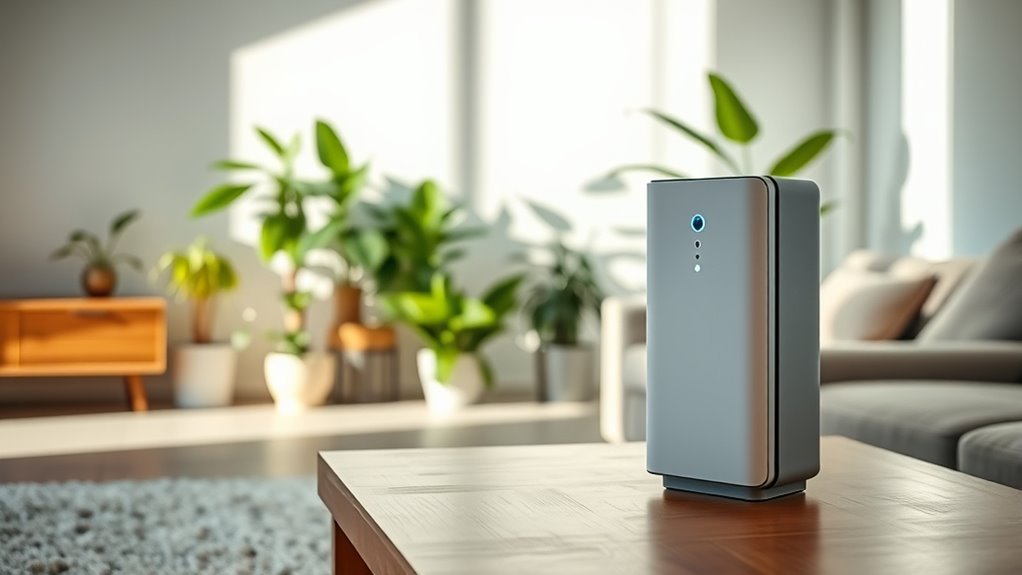
When choosing an air purifier, you’ll encounter various types, each with unique strengths and weaknesses. Mechanical filters are great for capturing particles, while activated carbon filters tackle odors and gases. However, be cautious with ozone generators, as they can pose health risks and aren’t as effective as you might hope. Additionally, it’s important to consider the impact of wood-burning emissions on indoor air quality, as they can significantly contribute to pollution levels. Proper venting techniques are essential to minimize these emissions and improve your indoor air quality. A high contrast ratio in the air purifier’s filtration effectiveness can enhance its overall performance. Furthermore, the growing trend of sustainable fashion has led to increased awareness about the impact of indoor pollutants, encouraging consumers to seek cleaner air solutions. Many air purifiers are now designed with energy efficiency in mind, which can help reduce overall energy consumption while maintaining air quality.
Mechanical Filter Overview
Mechanical filters play an essential role in enhancing indoor air quality by effectively trapping harmful particles. HEPA filters, a key type of mechanical filter, capture at least 99.97% of particulate matter as small as 0.3 micrometers, making them excellent for reducing indoor allergens like dust, pollen, and pet dander. Moreover, breast cancer awareness is crucial as it can lead to timely diagnosis and improve overall health outcomes. Additionally, incorporating air quality monitoring systems can help assess the effectiveness of HEPA filters in real-time. Moreover, understanding tax-efficient growth strategies can influence your choices in improving overall wellness through air quality. Furthermore, using a vacuum with specialized pet hair removal features can further aid in decreasing allergens in your home.
While activated carbon filters help with odors and gases, they need replacement every three months for ideal air purification. In contrast, ozone generators aren’t safe; they release ozone, a lung irritant. Similarly, electrostatic precipitators and ionizers can produce ozone and are less effective against odors. For reliable air purification, focusing on high-quality mechanical filters like HEPA is your best bet for maintaining a healthier indoor environment. Additionally, implementing real-time monitoring systems can help ensure that the air quality remains consistently optimal.
Activated Carbon Functionality
Activated carbon filters are essential for tackling indoor air pollutants, particularly gases and odors. They excel at reducing volatile organic compounds (VOCs) and other gaseous pollutants by adsorbing harmful chemicals onto their surfaces.
While HEPA filters effectively capture particulate matter, activated carbon filters focus on improving air quality by handling odors and fumes. However, remember that these filters need more frequent replacement—typically every three months—to maintain their effectiveness.
Some air purifiers combine HEPA and activated carbon filters, offering a thorough solution for your indoor air quality needs. The performance of activated carbon filters can vary based on the type of carbon used and the specific contaminants targeted, so choose wisely for the best results in your space. Additionally, incorporating essential oils into your cleaning routine can further enhance indoor air quality by reducing reliance on harsh chemicals.
Ozone Generators Risks
While many people seek effective air purification solutions, ozone generators can pose significant health risks.
These devices produce ozone, a lung irritant that can worsen respiratory conditions like asthma, especially in children and those with pre-existing issues.
Studies indicate that ozone levels from these generators often exceed safe limits set by the Environmental Protection Agency (EPA).
Unlike HEPA filters, which trap harmful particles and improve indoor air quality, ozone generators fail to effectively remove particulate matter.
The EPA advises against using ozone generators in homes, highlighting the availability of safer alternatives for air purification.
If you’re looking to enhance your indoor air quality, consider opting for HEPA-filter equipped air purifiers instead.
Benefits of Using Air Purifiers
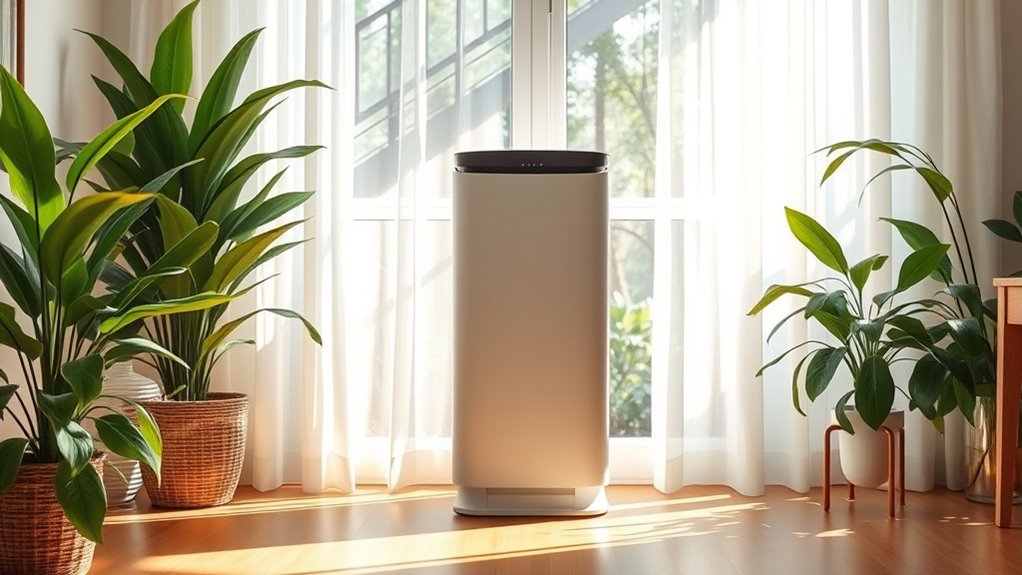
Using air purifiers can greatly relieve allergy symptoms by filtering out dust, pet dander, and pollen from your indoor environment.
You’ll notice improved air quality as these devices can considerably reduce harmful particles, making it easier to breathe.
With cleaner air, you’re not just enhancing comfort; you’re also taking a step toward better health.
Allergy Symptom Relief
Air purifiers can be a game-changer for anyone struggling with allergies. By using HEPA filters, these devices capture 99.97% of airborne particles as small as 0.3 micrometers, effectively filtering out common allergens like dust, pet dander, and pollen.
With regular use, air purifiers can greatly reduce indoor air pollution, cutting PM 2.5 concentrations by over 50%. This means fewer allergy symptoms for you, such as itchy eyes, runny noses, and respiratory issues.
If you live in a wildfire-affected area, air purifiers can help minimize smoke particles that worsen allergy and asthma symptoms. Plus, they reduce odors and gaseous pollutants, creating a healthier indoor environment that further alleviates your discomfort.
Improved Air Quality
When you invest in an air purifier, you’re not just improving your immediate comfort; you’re also enhancing the overall air quality in your home.
Here’s how air purifiers can lead to improved health:
- Allergen Reduction: HEPA filters capture 99.97% of allergens like dust and pollen, minimizing triggers for seasonal allergies.
- Respiratory Relief: Studies show air purifiers can reduce indoor PM 2.5 concentrations by over 50%, lowering respiratory issues.
- Smoke Particle Filtration: By filtering out smoke particles and odors, air purifiers create a more pleasant environment for those sensitive to tobacco or cooking fumes.
- Cancer Risk Mitigation: Improved indoor air quality can reduce exposure to pollutants linked to certain cancers, promoting a healthier living space.
Who Should Consider an Air Purifier?
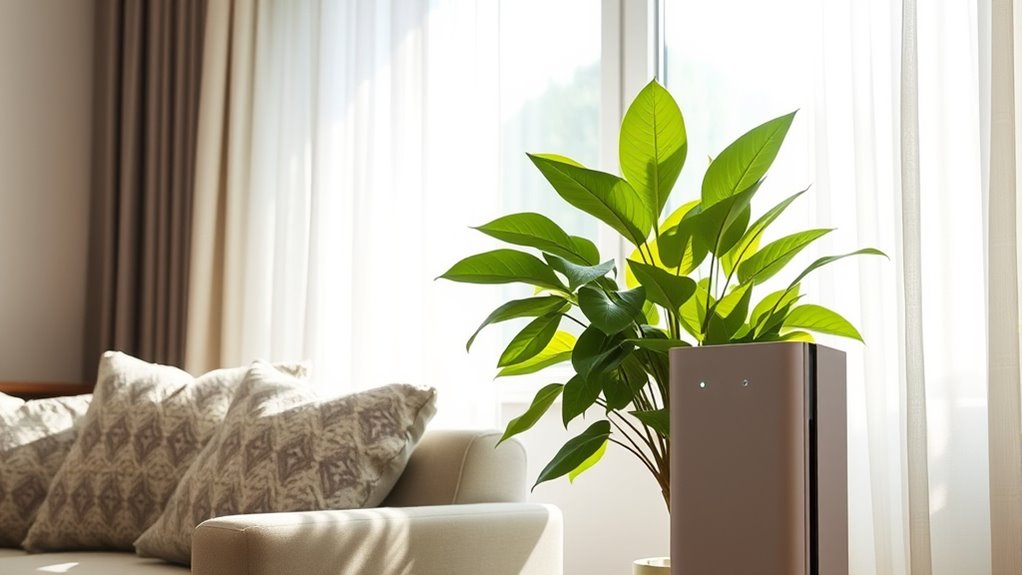
If you suffer from allergies or asthma, an air purifier might be a game-changer for your indoor environment.
Air purifiers equipped with HEPA filters can capture 99.97% of airborne particles, greatly reducing allergens like pollen, dust, and pet dander.
HEPA filter air purifiers capture 99.97% of airborne particles, significantly minimizing allergens such as pollen, dust, and pet dander.
If you live in an area prone to wildfires, consider one that filters smoke particles, as air quality can drop dramatically during these events.
Additionally, homes with pets can benefit from reduced pet dander and odors.
If you’re concerned about indoor air pollution, look for air purifiers with activated carbon filters, which target dust, mold, and VOCs.
How to Choose the Right Air Purifier
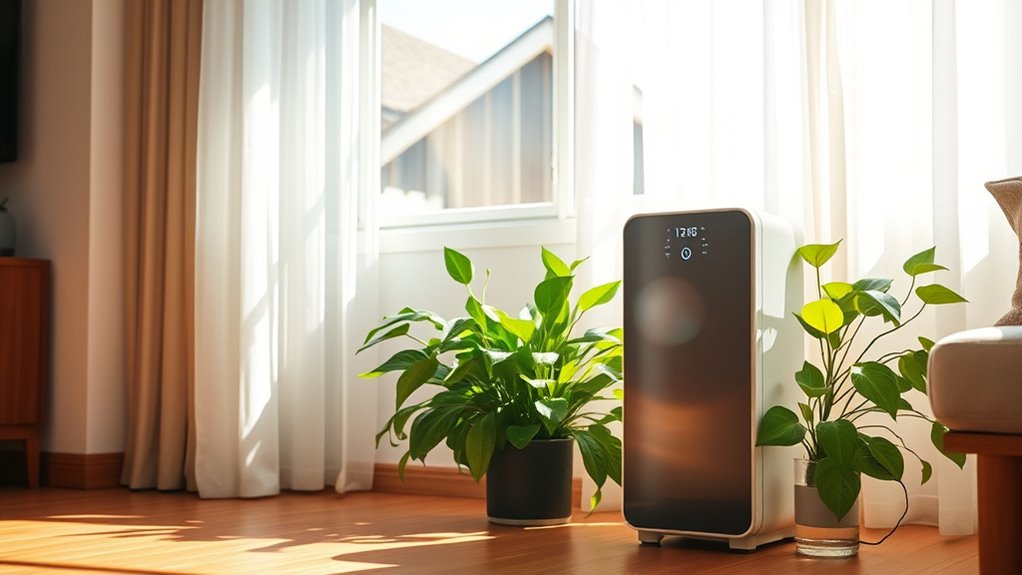
When you’re picking an air purifier, start by evaluating your room size to guarantee you get one that fits your needs.
Consider the type of filter, like HEPA, for maximum allergen capture.
Don’t forget to factor in maintenance costs for replacement filters to avoid surprises later on.
Assess Room Size
Choosing the right air purifier starts with evaluating your room size. To guarantee effective air filtration, consider these key factors:
- CADR Requirement: Aim for a Clean Air Delivery Rate (CADR) that’s at least two-thirds of your room’s area.
- Room Size: Small air purifiers typically cover areas up to 225 sq. ft., while larger models can handle spaces over 2,600 sq. ft.
- AHAM Seal: Look for the Association of Home Appliance Manufacturers’ Verifide seal to find suitable room sizes for specific models.
- Specifications Check: Regularly review the manufacturer’s specifications to verify the air delivery rate aligns with your room dimensions for ideal indoor air quality.
Filter Type Consideration
After evaluating your room size, the next step is to contemplate the filter type that best meets your air purification needs.
Consider models with HEPA filters, as they capture at least 99.97% of particles sized 0.3 micrometers, effectively targeting allergens like dust and pollen.
If you’re concerned about gaseous pollutants, activated carbon filters are vital, as they remove volatile organic compounds (VOCs) and odors that HEPA filters can’t handle.
Pay attention to the Clean Air Delivery Rate (CADR); a rating that’s two-thirds of your room’s area guarantees superior performance.
Don’t forget to regularly check and replace filters according to the manufacturer’s instructions to maintain indoor air quality, keeping your environment fresh and healthy.
Maintenance and Costs
To guarantee you get the most out of your air purifier, it’s crucial to take into account maintenance and long-term costs. Here are key aspects to evaluate:
- Replacement Filters: Mechanical filters need replacement every 6-12 months, while activated carbon filters should be changed every 3 months.
- Costs: Replacement filters can range from $20 to over $200, impacting your operating costs considerably.
- Clean Air Delivery Rate (CADR): A higher CADR indicates better performance for specific pollutants, so choose based on your air quality needs.
- Energy Efficiency: Opt for an Energy Star certified air purifier, which is 40% more energy-efficient, reducing long-term energy costs while improving indoor air quality.
Keeping these factors in mind will help you choose wisely.
Top Air Purifiers for 2025

Air quality plays an essential role in your overall health, and investing in an effective air purifier can make a considerable difference.
Air quality significantly impacts your health, making a reliable air purifier a valuable investment for your well-being.
The LEVOIT Air Purifier Core 300S-P is the best overall for 2025, offering Wi-Fi capability and exceptional performance at $149.99.
For budget-conscious consumers, the LEVOIT Air Purifier Core 300-P, priced at $99, still provides effective air purification.
If you need something for large rooms, the Medify MA-50 purifies spaces up to 2,640 sq. ft. in just one hour.
Pet owners should consider the Shark HP201 & HP202, designed to tackle allergens, though some users report issues with air quality sensor reliability.
Choosing the right air purifier can considerably improve indoor air quality in your home.
Maintenance Tips for Air Purifiers
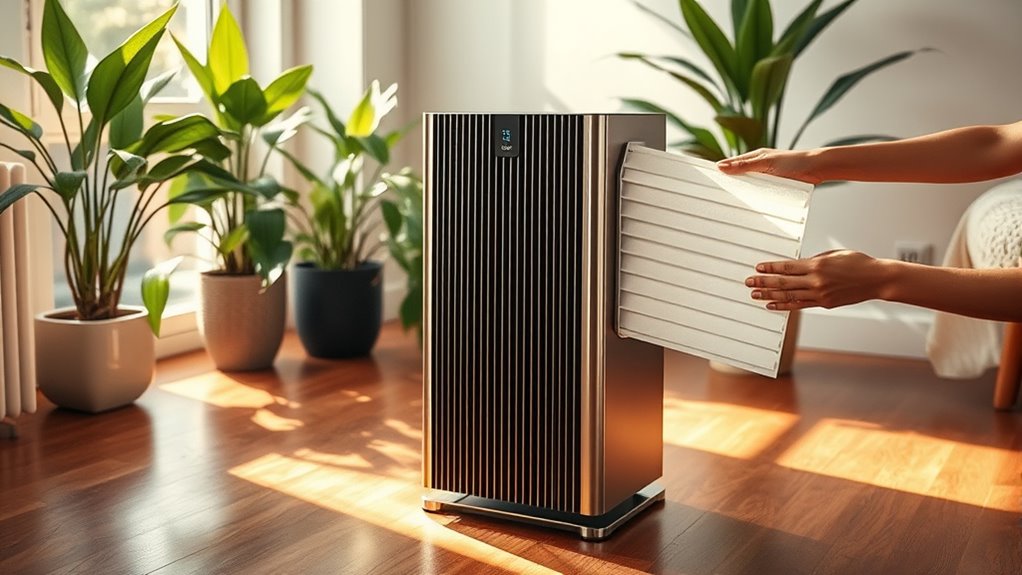
Maintaining your air purifier is essential for ensuring it works effectively and keeps your indoor air quality at its best.
Follow these maintenance tips to achieve peak air quality:
- Replace filters: Change mechanical filters every 6 to 12 months and activated carbon filters every 3 months.
- Clean pre-filters: Do this monthly to capture larger particles and extend the life of primary filters.
- Monitor filter service: Check indicator lights, if available, to avoid reduced efficiency due to clogged filters.
- Ensure proper airflow: Place the unit in an unobstructed area to maximize its effectiveness in circulating clean air.
Additional Ways to Improve Indoor Air Quality
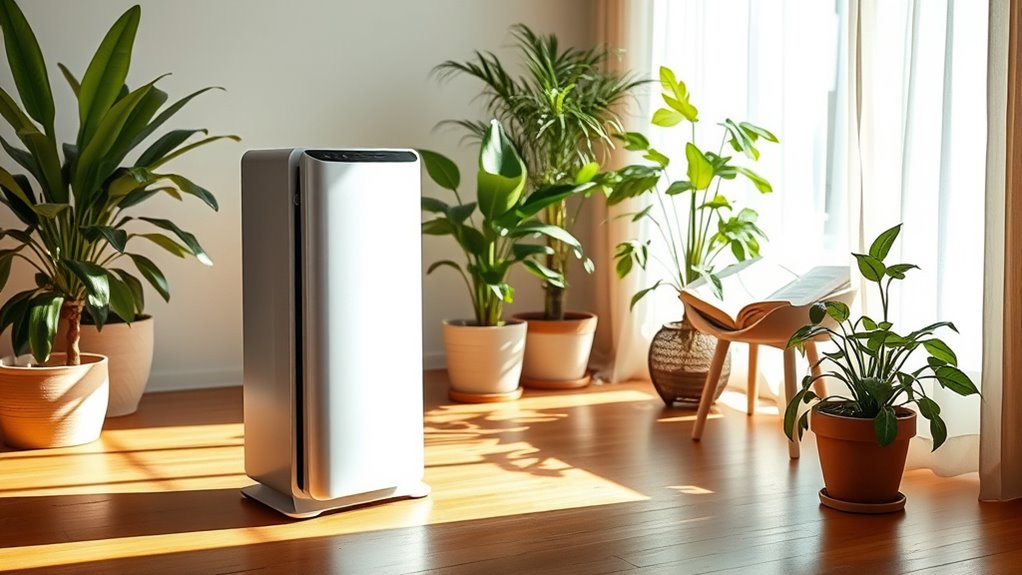
While you might think an air purifier is the only solution for indoor air quality, there are several other effective strategies to enhance your home environment.
Start by regularly vacuuming with HEPA-certified cleaners to reduce allergens like dust mites and pet hair. Improve your indoor air by using exhaust fans in kitchens and bathrooms to boost ventilation, effectively removing moisture and pollutants.
Regularly vacuum with HEPA cleaners and use exhaust fans to enhance ventilation and reduce indoor allergens.
Avoid indoor smoking and the burning of candles to minimize harmful byproducts. When the weather’s nice, open windows to let fresh air circulate.
Finally, limit the use of chemical-heavy cleaning products and store hazardous materials away from living areas to reduce VOCs and other harmful contaminants.
Implementing these strategies will greatly improve your indoor air quality.
The Role of Air Purifiers in Allergy Management
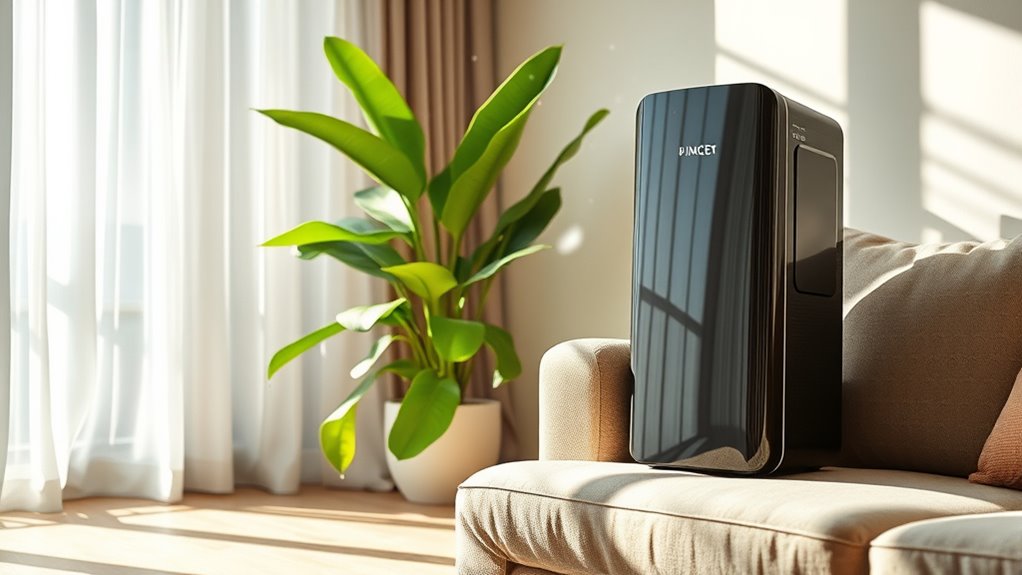
When it comes to managing allergies, incorporating an air purifier into your home can make a noticeable difference. Here’s how air purifiers can aid in allergy management:
- Capture Allergens: HEPA filters trap 99.97% of airborne particles, including pet dander, pollen, and dust mites.
- Reduce Respiratory Issues: By lowering indoor PM 2.5 concentrations by 50% or more, they help alleviate symptoms for asthma sufferers.
- Improve Indoor Air Quality: Regular use, especially during high pollen seasons or in homes with pets, can enhance your air quality.
- Filter Smoke Particles: In wildfire-affected areas, specific models can effectively remove smoke particles, promoting better overall air quality.
Integrating air purifiers with regular cleaning practices guarantees a thorough approach to allergy management.
Frequently Asked Questions
Do Air Purifiers Improve Indoor Air Quality?
Yes, air purifiers do improve indoor air quality. They capture allergens like dust and pet dander, helping you breathe easier.
By using a purifier with a HEPA filter, you’re reducing harmful particles in your space. Plus, if it has activated carbon filters, it’ll tackle odors and gaseous pollutants too.
Regular use can lower the risk of respiratory issues and enhance your overall well-being, especially if combined with routine cleaning.
Is There a Downside to Air Purifiers?
You might think air purifiers are a magic solution for clean air, but there’s a twist.
They can’t tackle all pollutants, especially those settled on surfaces. Some models even produce ozone, which can irritate your lungs instead of helping. Their effectiveness varies widely, and if you neglect maintenance, you risk worse air quality.
Plus, don’t forget those ongoing costs for energy and filters—sometimes, the investment isn’t as simple as it seems!
What to Know Before Buying an Air Purifier?
Before buying an air purifier, you should consider several key factors.
First, check the Clean Air Delivery Rate (CADR) to guarantee it matches your room size.
Look for HEPA filters to effectively capture harmful particles, while activated carbon filters tackle odors.
Don’t forget about maintenance; replace filters as recommended.
Noise levels matter too—opt for models around 50 decibels for quieter operation.
Finally, factor in replacement costs and energy consumption for overall affordability.
What Do Doctors Say About Air Purifiers?
Imagine your home as a sanctuary, free from the sneezing and wheezing that allergens bring.
Doctors suggest air purifiers, especially those with HEPA filters, to help you breathe easier. They can trap 99.97% of tiny particles like pollen and dust mites, reducing asthma symptoms.
However, they recommend using purifiers alongside good ventilation and regular cleaning. Not all purifiers are equal, so choose one with a solid Clean Air Delivery Rate for the best results.
Conclusion
In the quest for cleaner air, air purifiers are your trusty shield against pollutants, much like a knight defending a castle. By understanding how they work and choosing the right one for your needs, you can breathe easier and enjoy a healthier home. Don’t forget to maintain your purifier and explore other ways to boost indoor air quality. With these tools in hand, you’re well on your way to creating a refreshing atmosphere in your sanctuary.
